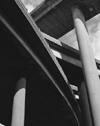 |
GROWING INWARD
REBUILDING THE CENTER CITY
| PRESENTED BY |
|
Columbus Metropolitan Club, Columbus Urban Growth Corporation, Greater Columbus Arts Council and the Ohio Arts Council |
     
|
|
|||||||||||||
Transit development is critical: People must have a choice of getting to work, shopping and recreation without using their cars. Although some people perceive transit as appealing to or serving only a narrow slice of the community, public investment in transit is more than justified. As Paul Weyrich noted, "Because mass transit may be used by everyone, it rightfully counts as infrastructure," just as streetlights, sidewalks and sewers do. It is well established that economic development follows transit improvements, particularly rail transit. Because rail transit is a fixed improvement that cannot be easily moved or re-routed, private investors feel comfortable with it and are willing to invest along and near transit lines and stations. Speaker Doug Kelbaugh made the case well: "Proceed as quickly as possible with a comprehensive transportation system that does not rely so exclusively on the single-occupancy automobile. When we invest in rail transit we are buying more than a transportation system. We are buying a predictable land-use pattern that will structure a metropolis in more livable, affordable and sustainable patterns, that will impart a greater regional consciousness and common identity in a way that rubber and asphalt never will. Pedestrians are the indicators of healthy urban areas, because the ingredients of a walkable urbanism are density, mixed use and transit. (Having) two out of three of these ingredients will not produce lasting walkability." |
||||||||||||||
| Introduction | Conclusion
| Speakers
| Sponsors Vision | Downtown | Policy | Transportation | Housing | Education Develop a Multi-Modal Transportation System |

